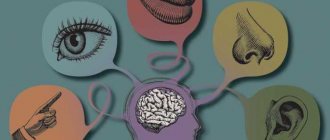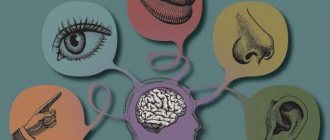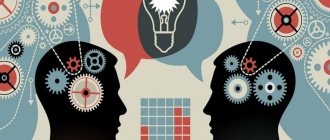Kinesthetics, what is it in psychology?
Kinesthetics is one of the channels for a person to perceive information coming from the outside.
This area is responsible for awareness of one’s own body, facial expressions, and physical contacts with other people.
Stroking, hugging, kissing, touching , all this is the area of kinesthetics.
More often, such a perception of reality is characteristic of women who have an increased need for tactile sensations.
In childhood, physical contacts also play an important role, as they help the child gain self-confidence and build trust in the world around him.
Physiological mechanism of sensations
The process of the emergence of sensations can be represented as follows. An irritant (music) with certain characteristics affects a certain sense organ (ears), which perceives information and transmits it along conductive pathways to the brain, where this information is processed, and we begin to hear music. This is how the surrounding world is reflected.
Charles Sherrington, an English physiologist, Nobel Prize laureate in physiology or medicine, proposed a classification of sensations according to the nature of reflection and location of receptors.
Sensations and feelings
A person of a kinesthetic type primarily experiences the world through sensations and feelings. Visual and auditory effects fade into the background for him .
In theoretical psychology, only proprioception . This is a set of signals coming from receptors in the skin, muscles, tendons, and joints.
They convey the basic sensations that arise during movement, contact with other objects, during changes in body position, etc.
Practical science considers this issue more broadly.
Kinesthetics includes the entire range of sensory experiences: touch, taste perception (sweet, salty, etc.), smells, thermoregulation, pain.
With the help of kinesthetic sensations, a person can analyze the position of his body or the movements performed by its individual parts, even with his eyes closed and the absence of sound signals.
During movements, signals are sent to the brain that are responsible for muscle tone and coordination.
Any movement is controlled by the brain. For this reason, loss of proprioceptive stimulation leads to motor disorders .
Kinesthetic cognition is directly related to vision. On the one hand, the individual visually determines distances using the sensations experienced.
On the other hand, in the absence of visual perception of reality, it is much easier to navigate in space if a familiar visual image is formed in the mind.
For example, when a person moves in a dark room, guided by the touch of his hands on surfaces, he unconsciously reproduces in his head a visual image of a familiar room.
Kinesthetic sensitivity plays a big role in skill development . The automated movements that people make are the result of the development of muscle memory.
Thus, in one’s own home, a person often does not use vision to turn on the light in the room. His hand automatically reaches for the switch, located in its usual place.
Adaptation, synesthesia, sensitization
Adaptation means that under the influence of the analyzers’ adaptation to the current stimuli, their sensitivity changes. It can occur in two directions: increasing and decreasing sensitivity.
Adaptation manifests itself in all types of sensations. It is especially noticeable in the areas of vision, smell, skin sensations and taste; less pronounced in the hearing area. For example, we need time to get used to bright sunlight after a dark room. Or you’ve noticed that if you spend some time in a room with an unpleasant smell, you won’t be able to smell it in the future.
Sensitization is an increase in the sensitivity of analyzers under the influence of internal (mental) factors. Caused by the interaction of different analyzers. Under certain conditions, it entails an increase in the sensitivity of one of the senses under the influence of the simultaneous functioning of the other. For example, the feeling of cold increases auditory and visual sensitivity, while high temperature and stuffy atmosphere lead to their decrease.
The phenomenon of compensation (reimbursement) often occurs. People suffering from a certain illness (for example, blindness) can compensate for this by increasing the abilities of another sense organ (hearing becomes more sensitive).
Synesthesia is the occurrence, under the influence of stimulation of one analyzer, of a sensation characteristic of other analyzers. You don't see this phenomenon often. An example is the many composers who had “colored” hearing (high sounds are most often recognized as “light”, and low sounds as “dark”.)
Who is a kinesthetic learner?
Kinesthetics are individuals who perceive reality through sensations. For them, touch becomes the main source of information.
During physical contact with other people or objects, the formation of a basic idea about them occurs. If for a visual learner to better assimilate information it is necessary to evaluate it with their eyes, and an auditory learner needs to listen, then it is important for kinesthetics to touch it.
It is a mistake to say that each person has only one channel of perception. As a rule, pure types are practically never found in nature. Kinesthetics may predominate in an individual, but this does not mean a complete absence of visual or auditory perception of reality.
The kinetic and kinesthetic development of the child is the basis of the cognitive development of children with SMDD.
Author: Elena Stanislavovna Fikleeva , teacher, State Budgetary Inpatient Social Service Institution of the Moscow Region Krasno-Dubravsky orphanage boarding school “Zhuravushka”.
Cognitive development involves the development of all types of mental processes: perception, memory, concept formation and others. In other words, it is the development of those mental processes through which we become aware and acquire knowledge, including sensation, recognition, imagination, symbolization, judgment, recollection, learning, reflection and inference. Scientists and physiologists, studying the functioning of the mechanisms of the human brain, have revealed that for the cognitive development of a child, sensory information is necessary, that is, information coming from the senses, in combination with personal and emotional experiences and movement. The famous outstanding Russian scientist-physiologist, creator of the science of higher nervous activity I.P. Pavlov believed that every thought ends in movement. He explained this by the fact that as a result of movement during mental activity, neural networks are built that make it possible to consolidate new knowledge. In this case, specific substances are released that promote the development of the nervous network. In turn, Doctor of Neurophysiological Sciences and educational specialist K. Hannaford, in her book “Wise Movement” wrote: “Deeply rooted in our society is the misconception that the mind and body are separate phenomena and that movements have nothing in common with the intellect... This is connected with the philistine view of the body: the bodily functions, sensations and emotions that ensure our life are lower, less human than the intellect... As if the role of the body is to “transport” the brain from place to place and thus ensuring his important work... But not all thinking and learning is concentrated only in the head. On the contrary, our body and physical exercise from infancy and throughout life play a vital role in the formation of the network of nerve cells that results from learning.” This is why the cognitive development of an immobile or mobility-impaired child is so problematic. Before talking about the characteristics and possibilities of cognitive development of children with SMDD, it is necessary to define what is meant by the term “children with severe multiple developmental disorders.” This category of children has a pronounced lack of cognitive development in combination with severe motor impairments. Their intellect, sensory sphere, speech and communication, general and fine motor skills, self-regulation of behavior and activity suffer, sensorimotor coordination is impaired, they do not know how to quickly and accurately start moving, change the tempo and rhythm of movements. It is the motor disorders of children with SMDD that are an integral part of the main defect and are determined by the same mechanisms as the main defect. Insufficient development of fine motor skills, kinetic and kinesthetic manual praxis (that is, the ability to perform purposeful motor acts), complex coordinated movements is determined by the underdevelopment of the analytical-synthetic activity of the cerebral cortex, and as a consequence - by the underdevelopment of the motor-kinesthetic analyzer. Currently, one of the pressing problems of specialists working with children in this category is the organization and implementation of correctional and developmental work to develop kinesthetic and kinetic sensations and perceptions of children with intellectual disabilities. The motor and cognitive development of children with SMDD is equally important, as is the development of hearing and vision. But you can never know what maximum level of development in each of these areas a child with SMDD will be able to achieve. It is quite possible that development will be minimal, and he will never learn to walk, talk and take care of himself. It was this conviction, until recently, that made it possible to think that it was pointless to develop and teach such children anything. Despite all of the above, the practice of teachers working with children in this category shows that there are no children who do not develop at all. Every child develops if it is encouraged. Therefore, it is so important to teach a child to interact and communicate with the people around him. And it is even more important to make this child understand that he himself can influence the world around him through his own activity. This is why the development of motor activity, kinetic and kinesthetic sensations is so important for children with SMDD. Also I.M. Sechenov, an outstanding Russian scientist, believed that “muscle feeling” is not only a regulator of movement, but also the psychophysiological basis of spatial vision, time perception, objective judgments and inferences, abstract verbal thinking, thereby recognizing the significance of kinesthetic sensations in human mental activity.
Channel of perception
Since people with a kinesthetic channel of perception experience the world through feelings and tactile contacts, it is important for others to properly communicate with them.
To win over such an individual and attract his attention to the conversation, you need to put your hand on the shoulder, touch the wrist, hug, etc.
Often such people in a conversation make the same movements with a certain frequency: they rub their eyes, twirl some trinket between their fingers, tap a pen on the table, etc.
Positive emotions in kinesthetics are caused by any pleasant experiences : warmth, softness, pleasant taste, unobtrusive movements.
The sense of smell also plays an important role. Such individuals always feel more comfortable in a room that smells delicious.
Experts recommend that parents and teachers identify the predominant channel of perception in children at an early stage and transmit information to them accordingly.
A kinesthetic child will understand well an adult who periodically strokes his hand, hugs him, etc. A student only needs an approving tap on the shoulder to experience positive emotions and gain self-confidence.
At the same time, it is important not to forget that adequate knowledge of reality is possible only by using all channels. Therefore, sensory sensations must always be supplemented by visual and auditory perception.
Characteristics of the thinking system
Kinesthetic learners primarily trust their senses. They view any events, objects and people through the prism of emotions that arise as a result of interaction .
If, during communication with a kinesthetic learner, the interlocutor demonstrates openness and goodwill, uses handshakes, touches, and claps, then the likelihood of consolidating a positive impression is quite high .
Since information is perceived by individuals in a tactile manner, all thoughts about the issue under discussion are expressed similarly: “I can’t accept this,” “I was touched by this topic,” “I feel what the conversation will be about,” etc. d.
The greatest attention of a kinesthetic learner is attracted to the topic that captures his attention as much as possible. In this case, the risk of being distracted by your own thoughts and experiences is reduced.
So, when presenting information exclusively out loud (for example, during a lecture), you cannot count on good concentration.
But if the same material is supplemented with colorful illustrations that add emotional coloring to the process, the kinesthetic learner is more likely to focus on the topic.
Sensitivity thresholds
So, in order for a person to feel the effect of any stimulus, the intensity of this stimulus must have a certain value (if you are standing at a distance of a kilometer from your interlocutor, a whisper is clearly not going to help you). You can take this situation as an example.
You ask your friend, who is at a distance from you, how he is doing. But he didn’t hear you, since your voice as an irritant does not have the required intensity. You ask a little louder in hopes that he will hear you. But the interlocutor hears something vaguely reminiscent of your question. Your friend’s senses (ears) have perceived this information, but if you repeat this question a little quieter, he will no longer hear. This is called the lower absolute threshold of sensitivity, i.e. the minimum strength of the stimulus causing a barely noticeable sensation. At one point, you get tired of choosing the right sound level, because your friend can’t hear you well anyway. Instead of just walking up to him, you decide to scream at the top of your lungs so that he can definitely hear you. And you started screaming without noticing your other friend who approached you from the other side. For him, this volume level was too high, it caused pain. This is called the upper absolute threshold of sensitivity, i.e. the maximum magnitude of the stimulus at which sensations disappear or change (for example, turn into pain).
Sensation thresholds are the ability of analyzers to reflect individual properties of stimuli or subtle differences between them. Psychophysics, whose founder is considered to be Gustav Theodor Fechner, studies and measures sensation thresholds.
The absolute threshold of sensation is the minimum value of the stimulus at which sensation first occurs. Stimuli that do not reach it lie below the threshold of sensations, i.e. we do not feel them (for example, dust particles that constantly fall on the skin). The weaker the stimuli that cause sensations (i.e., the lower the absolute threshold value), the higher the ability of the sensory organs to respond to these influences.
The difference (differential) threshold is the minimum change in the intensity of the stimulus, causing a barely noticeable change in sensations.
Difference sensitivity is a relative value. Ernst Weber came to the conclusion that we do not perceive differences between objects, but the relation of the difference to the size of the objects being compared.










